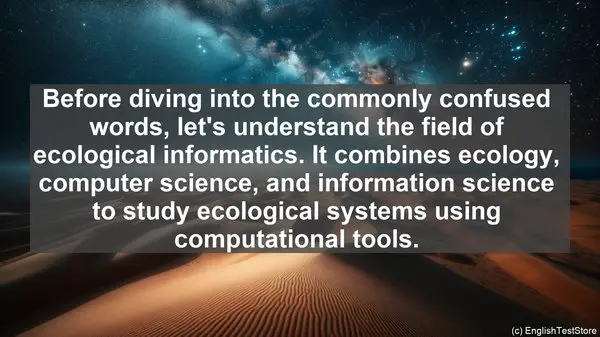Introduction to Ecological Informatics
Before diving into the commonly confused words, let’s understand the field of ecological informatics. It combines ecology, computer science, and information science to study ecological systems using computational tools.
Word 1: Data vs. Information
Data refers to raw, unprocessed facts, while information is data that has been processed, organized, and given context. In ecological informatics, data is collected from various sources, and then transformed into meaningful information for analysis and decision-making.

Word 2: Accuracy vs. Precision
Accuracy refers to how close a measurement or value is to the true or accepted value. Precision, on the other hand, refers to the level of detail or granularity in the measurement. In ecological informatics, it’s crucial to have both accurate and precise data for reliable analysis.
Word 3: Model vs. Simulation
A model is a simplified representation of a real-world system, while a simulation is the process of running that model to observe its behavior. Models are used in ecological informatics to understand complex ecological processes and predict their outcomes.
Word 4: Biodiversity vs. Species Richness
Biodiversity refers to the variety of life forms in a given area, including genetic, species, and ecosystem diversity. Species richness, on the other hand, specifically refers to the number of different species present. While related, they are not interchangeable terms.
Word 5: Correlation vs. Causation
Correlation means that two variables are related or co-vary, but it doesn’t imply a cause-and-effect relationship. Causation, on the other hand, suggests that one variable directly influences the other. In ecological informatics, it’s important to differentiate between the two when analyzing data.
Word 6: Sampling vs. Census
Sampling involves collecting data from a subset of a population to make inferences about the entire population. A census, on the other hand, aims to collect data from every individual in the population. Both approaches have their uses in ecological informatics, depending on the research question and resources available.
Word 7: Big Data vs. Long Data
Big data refers to datasets that are extremely large and complex, often requiring specialized tools and techniques for analysis. Long data, on the other hand, refers to datasets that span long periods of time. Both types of data are valuable in ecological informatics for understanding trends and patterns.

Word 8: Algorithm vs. Heuristic
An algorithm is a step-by-step procedure or set of rules for solving a problem. It’s often deterministic and guarantees an optimal solution. A heuristic, on the other hand, is a general problem-solving approach that may not guarantee an optimal solution but is often more practical. Both are used in ecological informatics, depending on the problem complexity and constraints.
Word 9: GIS vs. Remote Sensing
GIS (Geographic Information System) is a system for capturing, storing, analyzing, and visualizing spatial data. Remote sensing, on the other hand, involves acquiring data about the Earth’s surface from a distance, often using satellite or aerial imagery. While GIS can incorporate remote sensing data, they are distinct tools in ecological informatics.
Word 10: Metadata vs. Data
Metadata refers to data about data. It provides information about the characteristics, quality, and context of the actual data. In ecological informatics, metadata is crucial for understanding and interpreting datasets, ensuring their proper use and integration.
